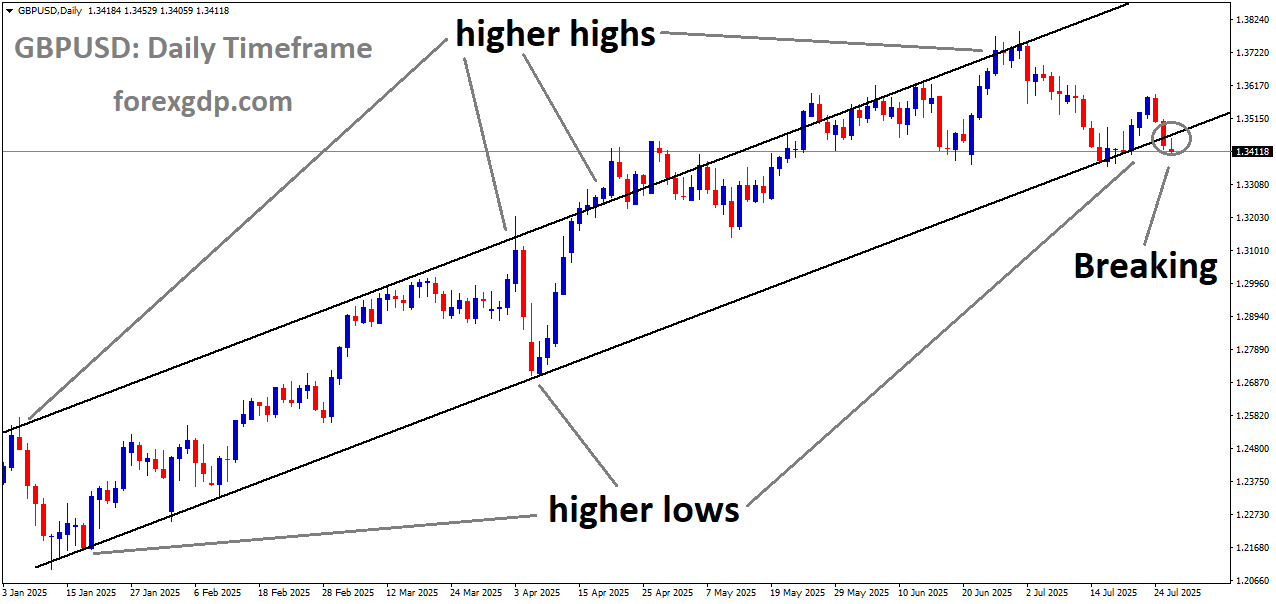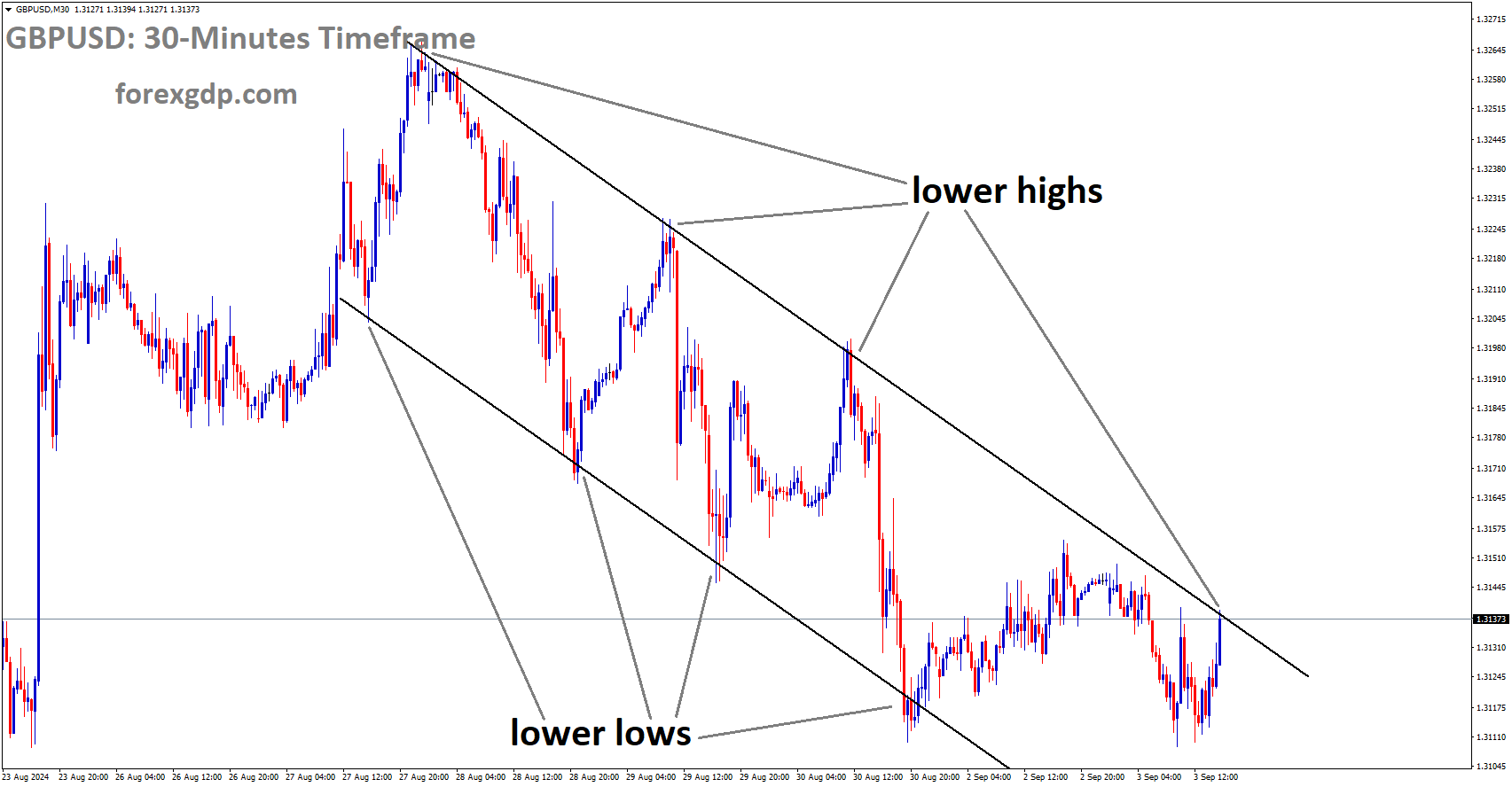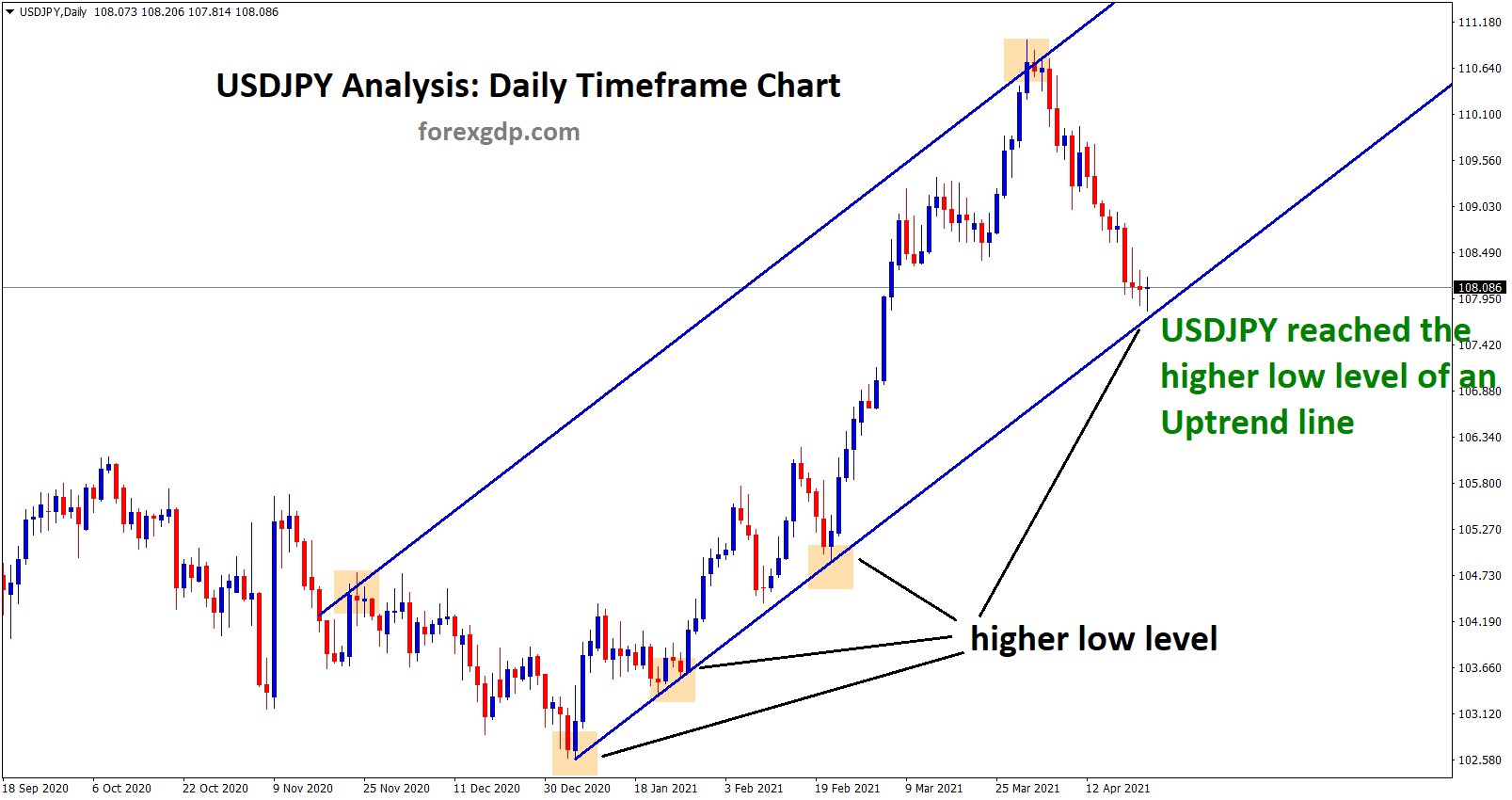GBPUSD is breaking the higher low area of the uptrend channel
GBPUSD Falls as US-EU Agreement Sparks Dollar Strength
The Pound Sterling hasn’t had the easiest ride lately, and if you’ve been keeping an eye on the markets, you’ve probably noticed it slipping closer to the lower range against the US Dollar. But what’s behind this movement? Is it just a normal market wobble, or are there bigger forces at play?
Let’s walk through what’s really going on behind the scenes, so you don’t have to decode technical jargon or track dozens of headlines.
A Trade Agreement Shakes Things Up
Sometimes, currencies move not because of what’s happening in their own economy, but because of what’s happening somewhere else. That’s exactly what’s happening with the Pound right now.
Recently, the United States and the European Union confirmed a new trade agreement. This deal has given the US Dollar a strong boost and made it more attractive to investors around the world. Even though this news doesn’t directly involve the UK, it still affects how the Pound trades against the Dollar.
Why Does a US-EU Deal Matter for the Pound?
Well, when big economies like the US and EU come to an agreement, it brings more stability and optimism to global markets. Investors often move their money toward what they see as “safe bets,” and right now, the US Dollar is one of those.
So when confidence in the Dollar grows, other currencies like the Pound often feel the pressure. This is one of the main reasons we’re seeing the Pound lose ground.
Market Expectations About Interest Rates
Another big driver of currency movement is what central banks are planning to do with interest rates. In the next few days, both the US Federal Reserve and the Bank of England are expected to make announcements—and the market is already reacting.
All Eyes on the Fed
Investors are betting that the US Federal Reserve will keep interest rates steady. That’s not really surprising, but the Fed’s decision still matters because it shows how confident they are about inflation and the broader economy.
More importantly, market watchers are waiting to hear what Fed Chair Jerome Powell says afterward. His comments about how trade policies may influence inflation could give some important clues about the future of interest rates in the US. If he hints at any changes ahead, that could mean more movement in the Dollar’s favor.
The Bank of England May Be Planning a Cut
On the UK side, the Bank of England is expected to lower interest rates soon. Investors are fairly certain that a rate cut is coming in the next announcement. This kind of policy shift usually weakens a currency because lower interest rates make it less attractive to hold assets in that currency.
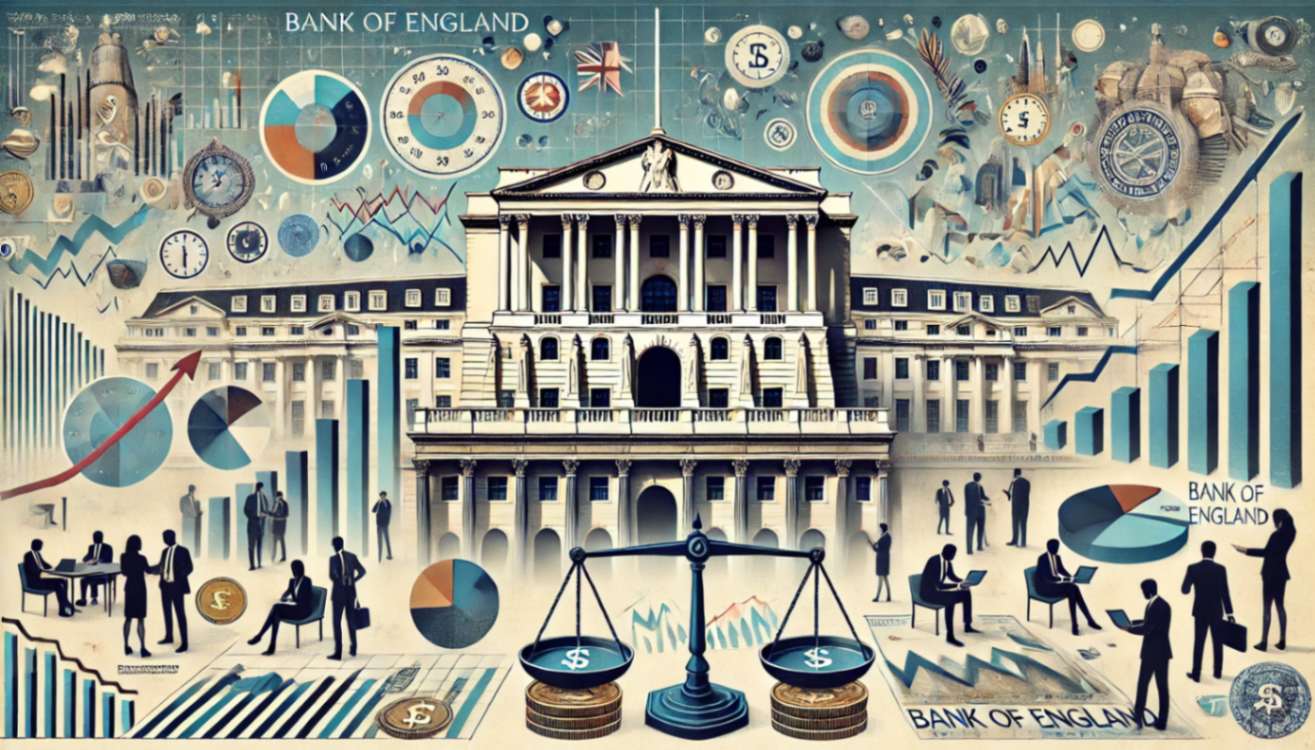
The Bank of England’s potential rate cut isn’t coming out of the blue. It’s tied to signs that the UK economy is slowing down—particularly when it comes to jobs and wages.
UK Employment Challenges Weigh on the Pound
One of the reasons why the Bank of England is expected to cut rates is due to softening in the labor market. The most recent data points to a notable slowdown in employment growth. That’s a red flag for policymakers, and it’s also something that currency traders watch very closely.
What’s Causing the Labor Market Slowdown?
A big part of it comes down to policy changes. The government recently increased employer contributions to the National Insurance scheme. This change makes it more expensive for businesses to keep or hire staff, and it has started to show in employment data.
Additionally, recent reports indicate that the number of staff has dropped at the fastest pace in several months. This decline suggests businesses may be bracing for tougher times ahead, and that’s not good news for the Pound.
What’s Next for the Pound-Dollar Pair?
So what can we expect moving forward? With both the Federal Reserve and the Bank of England set to make policy announcements, we’re likely to see more movement in the GBP/USD pair. But the bigger picture is also shaped by international trade relations and broader economic indicators.
While the US is benefiting from fresh trade deals and stable policy signals, the UK is navigating a slower labor market and potential rate cuts. This imbalance puts the Pound at a disadvantage, at least for now.
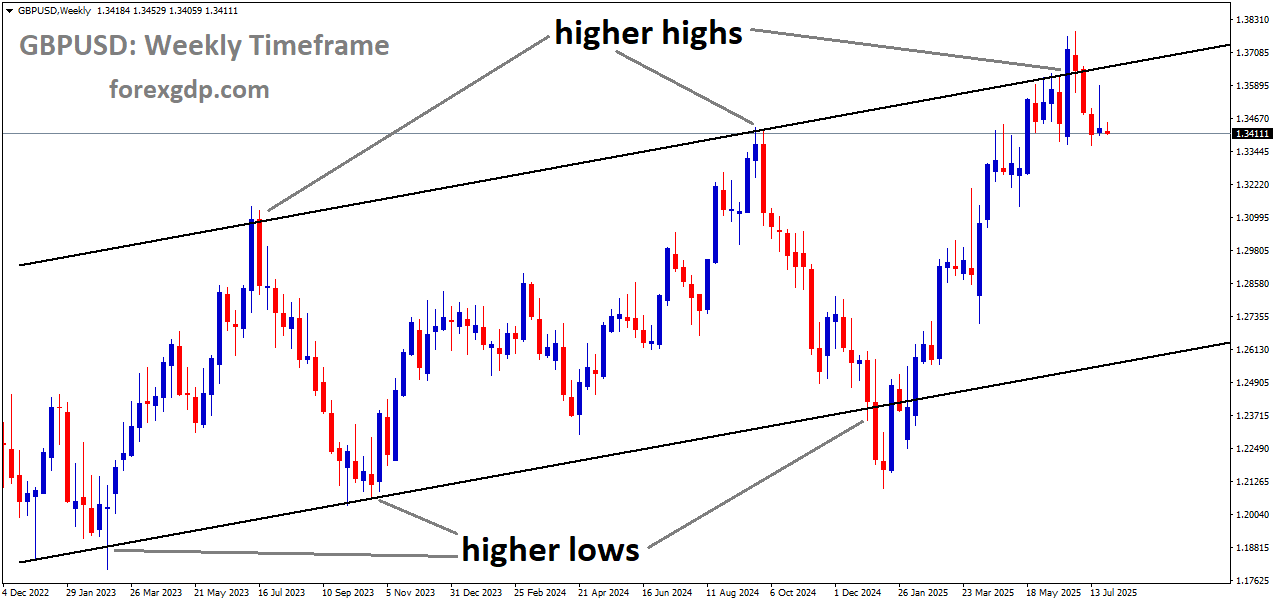
GBPUSD is moving in an Ascending channel, and the market has fallen from the higher high area of the channel
Also, let’s not forget about the US-China trade talks that are kicking off soon. While they don’t directly involve the UK either, any major developments could impact global investor sentiment—and that always has a ripple effect on currency values.
Final Summary: What It All Means for You
The Pound’s recent dip against the Dollar isn’t just a random market fluke. It’s the result of stronger investor confidence in the US economy, driven by fresh trade deals and stable policy expectations. At the same time, the UK is dealing with weaker employment numbers and likely interest rate cuts, both of which add pressure to the Pound.
If you’re someone who keeps an eye on exchange rates—whether for business, travel, or investing—it’s important to watch these big-picture developments. The Pound might continue to face challenges in the short term, especially if the Bank of England does go ahead with a rate cut.
But as always, markets can shift quickly. Keep an eye on updates from both central banks and stay tuned to global trade talks. These will be the key factors shaping where the Pound heads next.
EURUSD Dips Again With Greenback Climbing on Fresh EU-US Agreement
When a big trade deal between the European Union and the United States was finally signed, many expected it to be a turning point for the Euro. After all, two of the world’s largest economies agreeing to cooperate on trade and investment should have been a confidence booster. But here’s the catch—markets didn’t quite buy into the hype.
Instead of seeing a rise in the value of the Euro, investors reacted cautiously. The new agreement involved some hefty commitments from the EU, and when traders looked at the fine print, it wasn’t as impressive as it first seemed.
Let’s break down what happened and why it mattered.
The Eurozone’s Side of the Bargain
The heart of the deal was simple: Europe gets reduced tariffs on some of its products, but in return, it has to make massive investments in the US and buy lots of American gas and military gear.
At first glance, that sounds fair. But here’s what raised eyebrows:
-
Tariffs Drop, But Not Enough: European products, including key exports like pharmaceuticals and automobiles, will still face a 15% tariff. That’s lower than the 30% rate that had been threatened earlier, but still a far cry from the zero-tariff deal that Brussels originally hoped for.
-
Big Promises from the EU: In exchange, the EU agreed to invest around EUR 600 billion in the US and committed to purchasing about EUR 750 billion worth of American gas and military supplies. That’s a huge amount of money flowing out of the Eurozone and into the American economy.
So, while the deal avoided a full-blown trade war, it didn’t exactly scream “victory” for Europe. Investors noticed this, and the Euro didn’t get the boost some had expected.
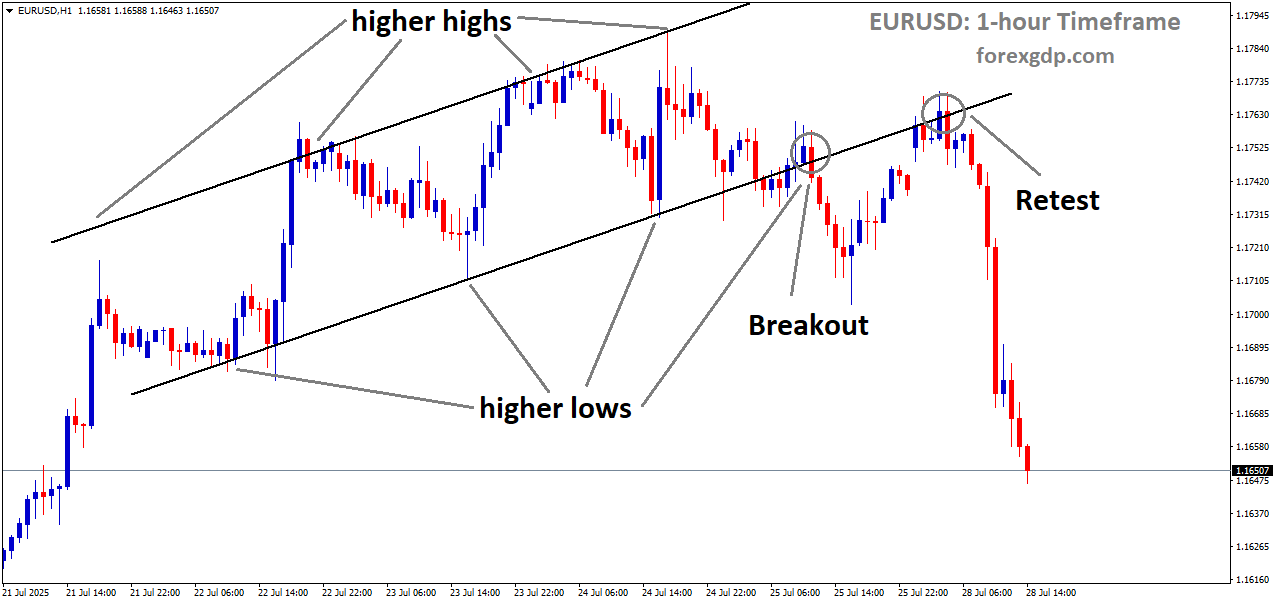
EURUSD is falling from the retest area of the broken uptrend channel
Why the US Dollar Stayed Strong
While Europe was making major commitments, the US Dollar remained steady and even gained some ground. Why? Because US economic data has been mostly holding up well. That kind of stability gives investors confidence.
Here are a few key reasons why the Dollar didn’t flinch:
-
Durable Goods Orders Surprised Everyone: The US recently reported a 9.3% drop in Durable Goods Orders. While that sounds bad, it was actually better than the 10.8% drop analysts had predicted. Plus, if you remove transportation equipment from the data (which can be very volatile), core Durable Goods actually grew slightly. That’s a good sign of resilience.
-
Job Market Shows Strength: The number of people filing for unemployment benefits dropped for the sixth week in a row. That kind of steady improvement points to a strong labor market—something that usually supports the currency.
-
The Fed Isn’t Budging on Rates: The Federal Reserve is playing it cool. Even with all the global economic uncertainty, they’re not rushing to cut interest rates. That’s partly because US data hasn’t been bad enough to force their hand. As long as the Fed holds steady, the Dollar tends to stay attractive to investors looking for a safe place to park their money.
How Markets Reacted to the Trade Deal
A Lukewarm Reception
You’d think a major international agreement like this would spark excitement. But for investors, the fine print told a different story.
European Commission President Ursula von der Leyen called it “the best deal we could get.” That kind of language suggests compromise, not triumph. Investors were hoping for a stronger win—something that would clearly benefit European exports and improve the balance of trade.
Instead, what they saw was a deal where Europe still pays tariffs and sends a large amount of capital to the US. That’s why the Euro began slipping, even as headlines talked about progress.

The “Buy the Rumor, Sell the News” Effect
There’s a common phrase in the trading world: buy the rumor, sell the news. It means investors often buy assets based on high hopes for an upcoming event—and then sell once the event happens, no matter how positive it is.
That’s exactly what happened with the Euro.
Traders were optimistic before the deal, hoping for big breakthroughs. But once the details came out, they started selling. The result? The Euro lost ground, and the US Dollar continued to look more attractive.
What Investors Are Watching Now
Even though this trade deal is big news, investors aren’t stopping to celebrate. They’ve already turned their focus to what’s next, especially in the US:
-
The Federal Reserve’s Policy Meeting: Investors are waiting to hear from Fed Chair Jerome Powell. His comments can sway markets in a big way, especially if he gives any hints about future interest rate changes.
-
US Jobs Report: The Nonfarm Payrolls report, which shows how many jobs were added in the US, is due at the end of the week. It’s one of the most closely watched pieces of economic data. A strong number could reinforce confidence in the Dollar.
-
GDP Updates: There’s also interest in updated US economic growth figures. If the economy is growing faster than expected, it gives the Fed more room to stay the course—and the Dollar more support.
In short, investors are more interested in what’s coming next than what’s already happened. And right now, the US still looks like the stronger player in the global economy.
Final Thoughts: Why This Deal Didn’t Help the Euro Much
The EU-US trade agreement was supposed to be a big deal. It reduced tariffs, avoided conflict, and committed both sides to stronger economic ties. But when you dig into the details, it’s clear why investors weren’t too excited.
Europe gave a lot—massive investments, large purchases of American goods, and only partial relief from tariffs. Meanwhile, the US got to maintain its economic advantage without giving up too much.
And with the US economy still showing resilience and the Federal Reserve standing firm on interest rates, the Dollar remains the safer, more appealing choice for now.
So if you were wondering why the Euro dropped instead of rising on such news, now you know. It’s not just about headlines—it’s about what those headlines really mean when you look a little closer.
USDJPY Breaks Higher, Powered by Dollar Momentum and Yen Weakness
When we talk about currencies and how they behave, there’s always more to the story than just numbers or charts. Lately, the Japanese Yen (JPY) has been slipping in value, and if you’ve been watching the USD/JPY pair, you’ve probably noticed the Dollar is gaining ground day by day. But what’s really going on here? Let’s break it down in a way that makes sense, without all the technical jargon.
What’s Pressuring the Japanese Yen Right Now?
No Urgency from Japan’s Central Bank
One of the biggest reasons the Yen is struggling is because the Bank of Japan (BoJ) doesn’t seem to be in any rush to raise interest rates. You might wonder, why does that matter?
Well, when a country’s central bank raises interest rates, it often makes that currency more attractive to investors. Higher interest means better returns for anyone holding that currency. But in Japan’s case, with inflation slowing down and political uncertainty at home, the BoJ is holding off on tightening its monetary policy.
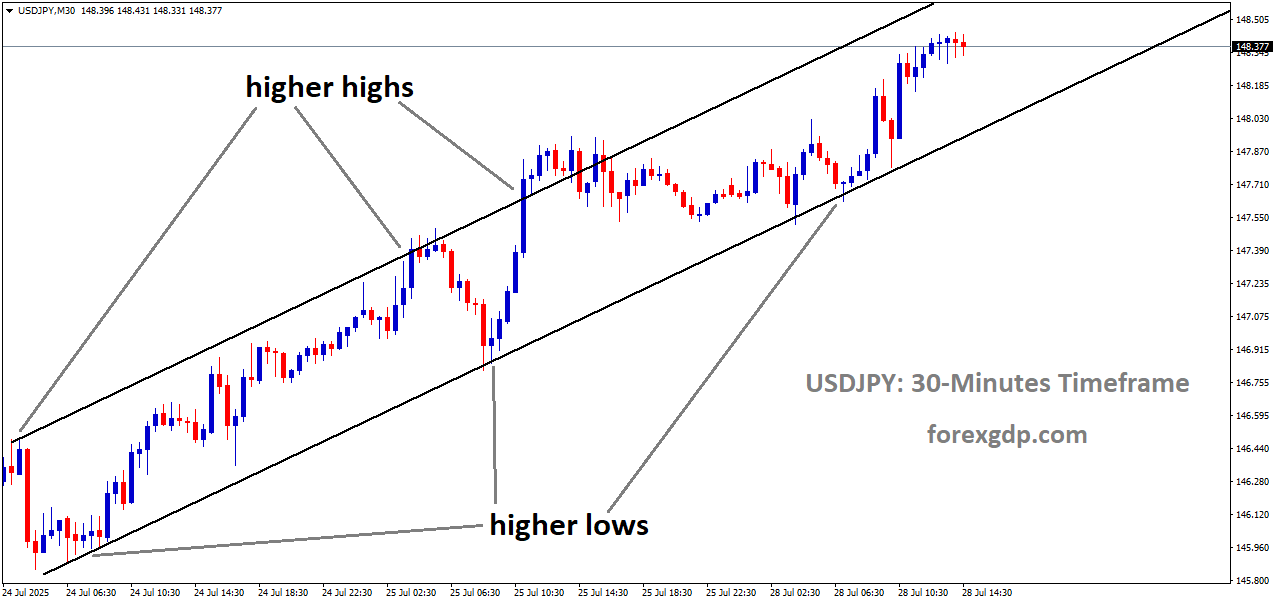
USDJPY is moving in an uptrend channel
This hesitation is making the Yen less appealing compared to other major currencies where central banks are either maintaining high rates or slowly tightening further. Investors tend to move their money to where they see stronger returns and greater stability—and right now, Japan isn’t offering that.
Market Optimism is Hurting the Yen
Here’s another layer to it: people feel pretty good about where the global economy is heading. There’s growing optimism around trade talks between major powers like the U.S. and China, and even between the U.S. and the European Union.
This “risk-on” mood in the market pushes investors to move their funds into assets with higher risk but better returns—like stocks or emerging market currencies. In contrast, the Yen is typically seen as a “safe haven” currency, something investors turn to when they’re scared or uncertain. So, when everyone’s feeling good about the market, the demand for the Yen usually drops.
Why the U.S. Dollar Keeps Gaining Strength
Strong Economic Signals from the U.S.
While Japan is holding back, the United States is showing signs of economic resilience. The labor market remains strong, consumer spending is steady, and inflation, while a concern, is being managed more aggressively by the Federal Reserve.
The Fed is likely to keep interest rates higher for longer, and that’s a big deal. Higher interest rates in the U.S. mean investors have more incentive to hold onto Dollars. That naturally drives up the value of the USD compared to weaker currencies like the Yen.
Investors Expect Stability in U.S. Policy
Another key factor is clarity. Investors prefer predictability, and the U.S. Federal Reserve has been relatively consistent in its messaging. Even if there aren’t immediate changes to the interest rates, the market generally knows what to expect. This level of transparency keeps the Dollar attractive and helps maintain its strength.

How Trade Developments Are Shaping Currency Moves
The U.S.–Japan Trade Deal Brings Mixed Feelings
Japan recently signed a trade deal with the U.S., which might sound like good news. And in some ways, it is. It reduces a layer of uncertainty for Japan’s economy, which can be good for business confidence.
But here’s the twist—just because the trade environment improves, doesn’t mean the Japanese Yen will automatically bounce back. In fact, some believe that this new sense of economic stability could give the BoJ even more reason to delay any aggressive policy moves. That keeps the Yen stuck in a weak position.
Global Trade Sentiment Lifts Risk Appetite
With both U.S.–EU and U.S.–China relations showing signs of improvement, investors are less inclined to play it safe. This positive trade sentiment encourages them to chase better returns elsewhere, further reducing the demand for the Yen. It’s like the Yen is being left behind while everyone else is moving forward with confidence.
What to Watch in the Week Ahead
This week is a big one for financial markets. Central banks on both sides—Japan and the U.S.—are expected to release important updates.
Even if neither the Fed nor the BoJ changes their interest rates, investors will be paying close attention to what they say about future plans. If the Fed hints at staying firm on rates or even tightening further, the Dollar could strengthen even more. Meanwhile, if the BoJ continues to show caution, the Yen could remain on the back foot.
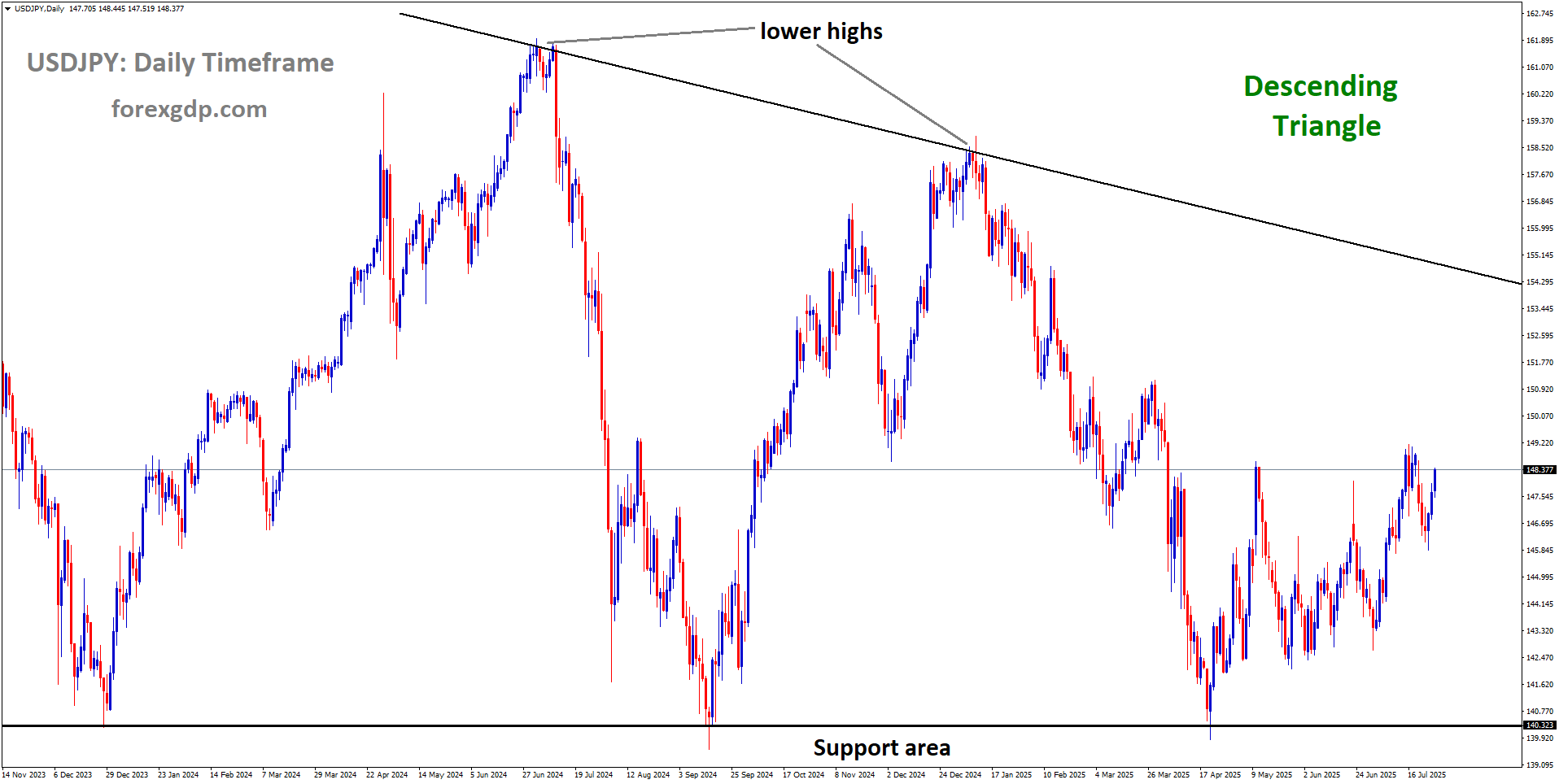
USDJPY is moving in a descending triangle pattern
There’s also a wave of important U.S. economic data on the horizon. Reports like GDP numbers, consumer spending trends, and the always-watched Nonfarm Payrolls will all help paint a clearer picture of where the U.S. economy is headed—and by extension, where the USD might go.
Final Thoughts: A Currency Tug-of-War
The recent moves in the USD/JPY currency pair aren’t just about one country doing better than the other. They’re about perception, policy, and momentum.
Right now, the U.S. is holding strong in the eyes of global investors. The economy is chugging along, the central bank is sticking to its plan, and there’s confidence in how things are being handled. On the other side, Japan is facing slower inflation, political uncertainty, and a cautious central bank.
Add a global market that’s in a “risk-on” mood, and it’s easy to see why the Yen is struggling while the Dollar stays strong.
As things unfold this week—with central bank updates and fresh economic data—we might see more moves, more reactions, and maybe even a shift in direction. But for now, the trend is clear: the Japanese Yen is facing headwinds, and the U.S. Dollar is catching the breeze.
USDCHF Holds Steady as Markets Eye Progress in US-China Trade Talks
The USD/CHF pair has been moving sideways lately, and there’s a lot going on behind the scenes that could influence where it heads next. If you’re someone who keeps an eye on currencies, especially the US Dollar (USD) and Swiss Franc (CHF), then you’re probably curious why this pair hasn’t made a big move in either direction. Let’s break down the bigger picture and explain what’s really driving this pair right now – without getting into complicated technical jargon.
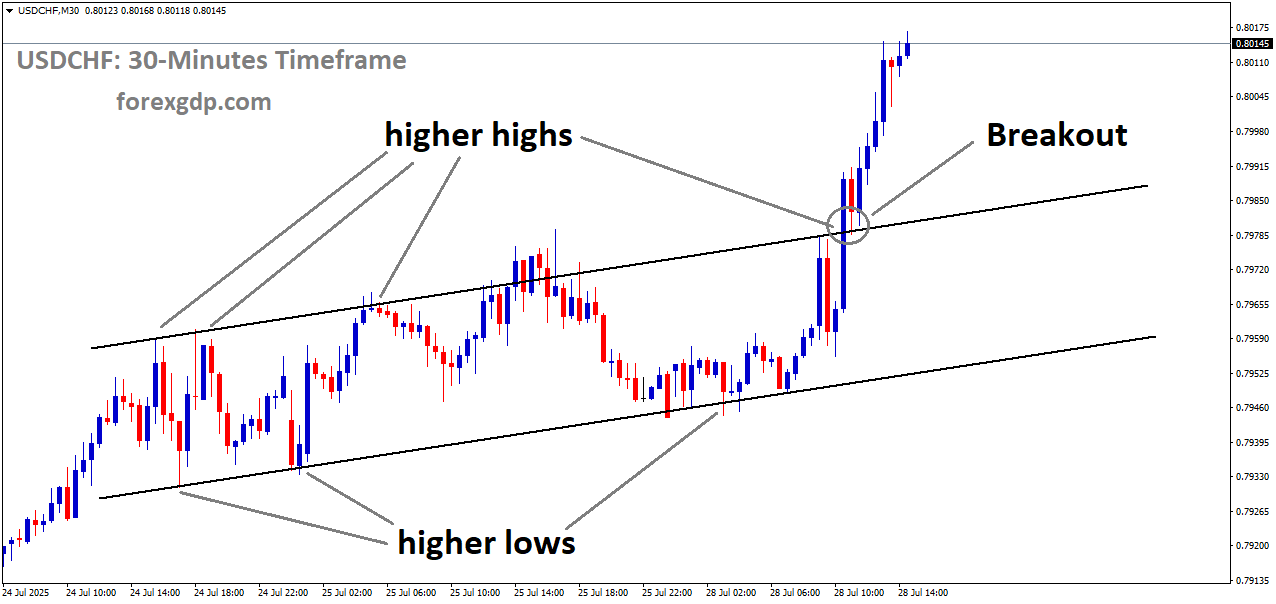
USDCHF has broken the Ascending channel on the upside
Global Trade Talks Are Changing the Vibe
One of the biggest influences on currency markets, especially for pairs like USD/CHF, is global sentiment. And recently, that sentiment has taken a positive turn.
A Boost in Confidence from the US and EU
The recent agreement between the US and European Union to establish a new trade framework has given global markets a much-needed dose of optimism. Essentially, both sides have agreed to place a general 15% tariff on goods traded between them. While this might sound restrictive at first, it’s actually being viewed as a way to add more structure and clarity to the relationship. And when big economies are getting along, investors start to feel safer.
Why does this matter for the Swiss Franc? Well, the CHF is what’s called a “safe haven” currency. People tend to buy it when the world seems risky and uncertain. But when global markets start to feel more stable – like they are now thanks to improving trade relationships – the demand for CHF tends to go down. That’s why we’ve seen the Franc lose some ground against the Dollar.
US and China are Playing Nice Too
In another encouraging move, the US and China are reportedly planning to extend their existing trade truce. According to media reports, both sides are expected to hold off on any new tariffs for now. On top of that, the US has temporarily eased export restrictions on key tech products going to China, signaling an effort to keep things smooth.
This is another sign that the world’s biggest economies are trying to avoid fresh conflict – and once again, this reduces the need for investors to park their money in safer assets like the Swiss Franc.
The Fed Is in Focus – But Don’t Expect Surprises
Whenever the US Federal Reserve is about to make a decision, the markets perk up. This week is no different. Everyone’s watching what the Fed will say and do – but interestingly, most experts agree that we shouldn’t expect any major rate changes just yet.
No Rate Cut This Week, But September Is a Maybe
The general expectation is that the Fed will hold interest rates steady for now. But that doesn’t mean traders will be tuning out. Instead, all eyes will be on what’s said during the press conference. People want to hear whether there are hints of a possible rate cut in September.
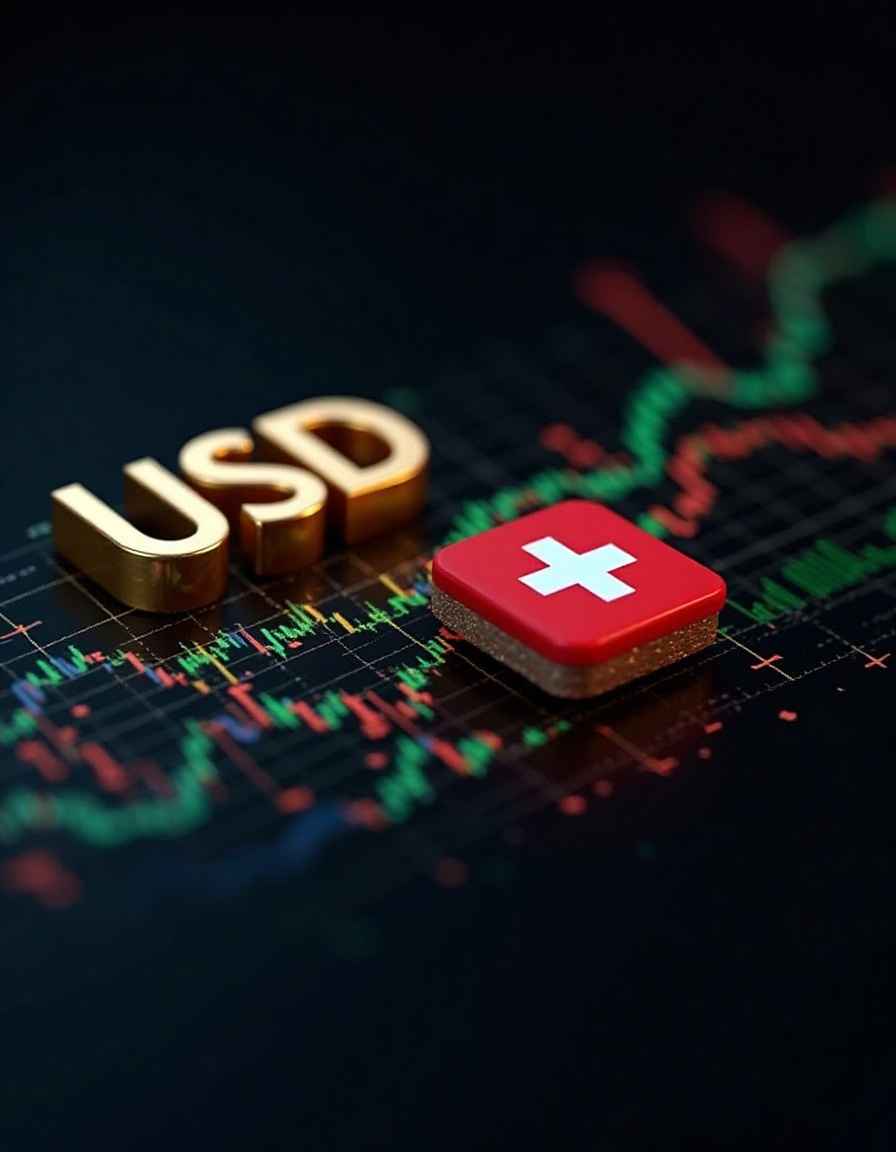
Why does this matter for USD/CHF? Because if the Fed starts sounding more cautious or hints that a rate cut is coming, that could weigh on the Dollar. Investors tend to move their money away from currencies that are tied to lower interest rates. On the flip side, if the Fed seems confident and sticks to a wait-and-see message, the Dollar might stay strong – especially compared to a weakening Swiss Franc.
Investor Mood Is the Real Driver Right Now
The key takeaway in all of this is that market sentiment is doing most of the heavy lifting. While central banks and economic policies always play a role, this current phase is being shaped largely by how comfortable – or uncomfortable – investors feel.
When People Feel Safe, CHF Takes a Backseat
Whenever the global mood shifts toward optimism, demand for safe-haven assets tends to fade. That’s exactly what’s happening with the Swiss Franc at the moment. With fewer fears about trade wars and global slowdowns, traders aren’t rushing into the safety of the CHF like they were before. That makes the USD more attractive in comparison, especially when the US economy is still looking relatively stable.
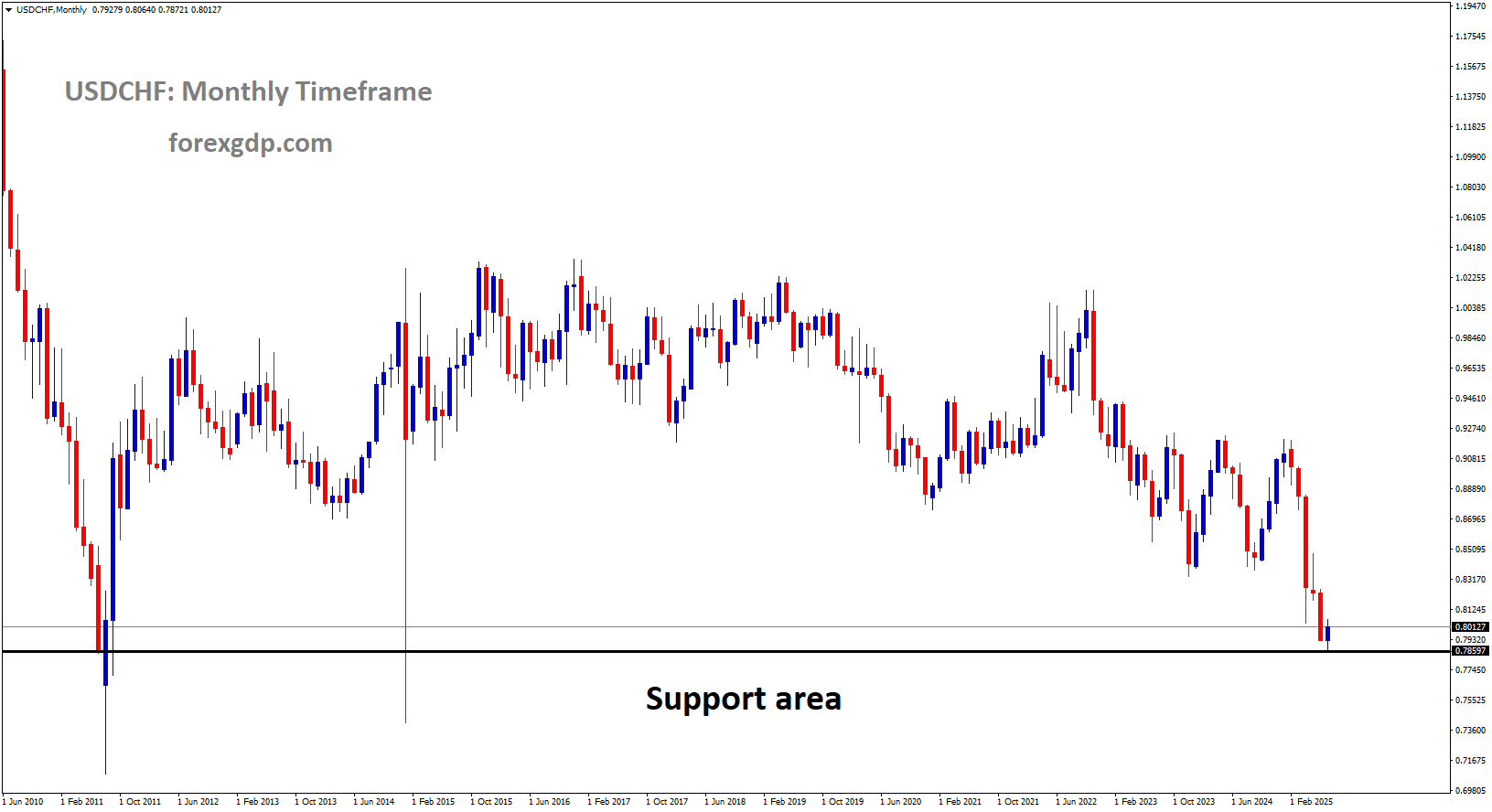
USDCHF reached a major support area
What to Keep an Eye On Next
So, where do we go from here? If you’re watching the USD/CHF pair closely, here are the main things to monitor:
-
Updates from the US-China trade front – If talks continue to go well, that’s more pressure on CHF.
-
Fed’s post-meeting commentary – Even without a rate change, the tone they use will be key.
-
General global sentiment – Watch how equity markets and commodities behave. A confident market usually means less interest in safe-haven currencies.
A Quick Wrap-Up
Right now, the USD/CHF pair is stuck in a sort of holding pattern – not because of price levels or technical reasons, but because the market is digesting some big-picture changes. Trade agreements between major economies are boosting confidence, which lowers the appeal of safer currencies like the Swiss Franc. Meanwhile, the US Federal Reserve is staying cautious and giving few clues, which is keeping traders from making bold moves.
If the mood stays positive globally, and the Fed doesn’t surprise with a rate cut too soon, there’s a good chance the Dollar could stay on firm footing against the Franc. But like always, unexpected headlines could shake things up – so it’s worth staying alert and keeping tabs on the next developments in trade and central bank policy.
In short, it’s less about numbers right now and more about how the world feels. And as long as that feeling remains optimistic, the Swiss Franc might continue to take a backseat.
EURGBP Climbs Higher as EU and US Strike Surprise Trade Agreement
When it comes to the forex market, things can change pretty fast. One moment a currency pair is treading water, and the next, it’s on a powerful upward climb. That’s exactly what we’re seeing with EUR/GBP lately. Let’s break down what’s happening with this pair — minus the complicated technical jargon — and get to the heart of what’s influencing its recent momentum.
The Big Trade Deal That Shook Things Up
One of the major reasons behind the recent rise of the Euro against the Pound has a lot to do with international trade dynamics — specifically between the European Union (EU) and the United States (US).
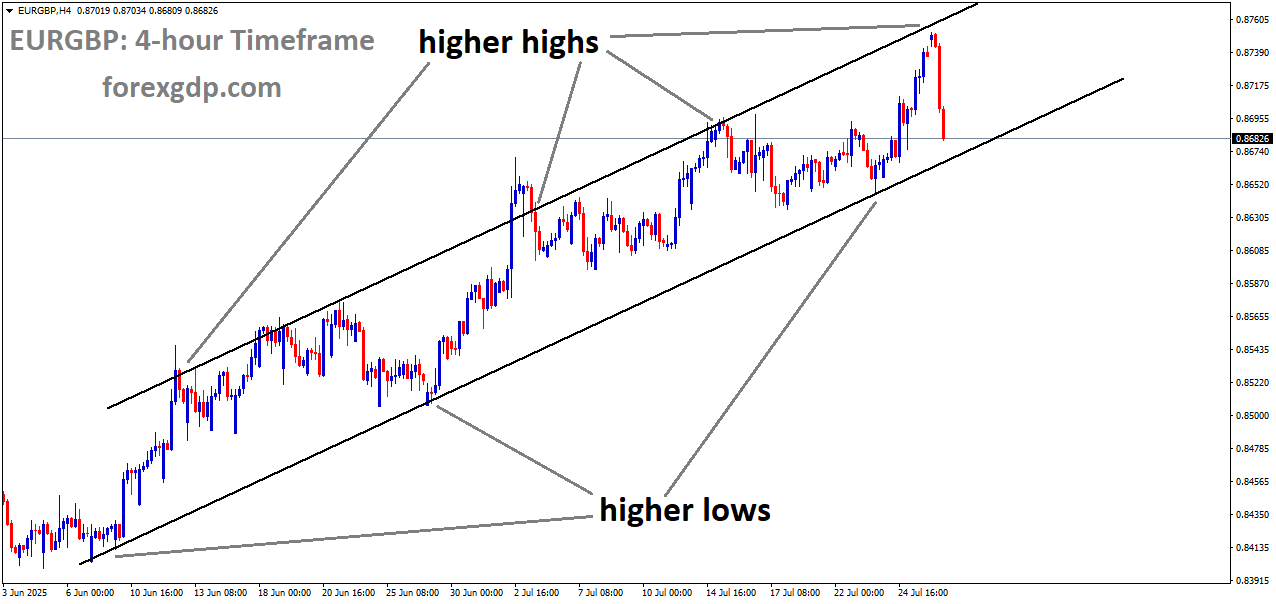
EURGBP is moving in an uptrend channel, and the market has fallen from the higher high area of the channel
A Surprising Turn in Trade Relations
On Sunday, a surprising and impactful development took place: the EU and the US reached a new trade agreement that calmed months of tension. For a while, there was a looming threat that the US would slap a hefty 30% tariff on all European goods. That could’ve hit EU economies hard, especially exports.
But instead, the two sides settled on a 15% tariff — cutting that threat in half. This new framework brings relief to European exporters and adds a layer of economic stability. Naturally, this kind of news gives the Euro a boost.
Even though this deal is seen as temporary and slightly one-sided (as pointed out by France’s European Affairs Minister), it still offers breathing room for businesses and investors. And in forex, even temporary relief can cause a shift in currency value.
UK Retail Struggles: Not as Strong as Hoped
Now, while the Euro is climbing, the British Pound isn’t exactly holding its ground. One of the big drags on the Pound lately has been weaker-than-expected retail sales in the UK. When consumers aren’t spending as much, it’s often a sign that the economy is slowing or that people are feeling cautious about their financial future.
Disappointing Retail Data
Recent figures showed that retail sales in the UK only increased by 0.9% in June. Now, that may sound decent, but when you compare it to the previous month’s sharp drop of 2.7%, or the forecasted recovery of 1.2%, it’s clear that the rebound wasn’t quite as strong as hoped.
This kind of economic softness makes investors think twice about betting on the Pound. And when one side weakens, the other gains — that’s exactly what we’re seeing with EUR/GBP.
Economic Clouds Over the UK
Retail sales aren’t the only concern for the British economy right now. A mix of other economic issues is also weighing on the Pound.
Private Sector Slowdown
There’s been a noticeable drop in private sector activity in the UK. This suggests that businesses — both in services and manufacturing — are experiencing slower growth or even contraction. When companies aren’t thriving, it often reflects in employment, investment, and overall confidence.
Cooling Job Market
On top of that, the labor market is showing signs of cooling off. Fewer job openings, slower wage growth, and less hiring activity make people more cautious with their money — which again ties back into weaker retail sales.
All these factors together paint a picture of an economy that’s not firing on all cylinders. And that puts pressure on the British Pound, especially when compared to a more stable or improving Eurozone.

Eurozone in Focus: GDP Numbers Ahead
Now, while the Euro has gotten a recent boost from the US-EU trade deal, the story doesn’t stop there. Investors are also closely watching what’s coming next from the Eurozone, particularly the upcoming GDP figures.
Germany and Eurozone Growth
Germany — the biggest economy in the Eurozone — and the broader EU are set to release preliminary GDP data soon. These numbers will give a clearer picture of how the economy performed in the second quarter of the year.
Strong figures could reinforce the Euro’s current strength, while weak data might throw cold water on the rally. Either way, these reports are highly anticipated and could be another big driver for the EUR/GBP pair moving forward.
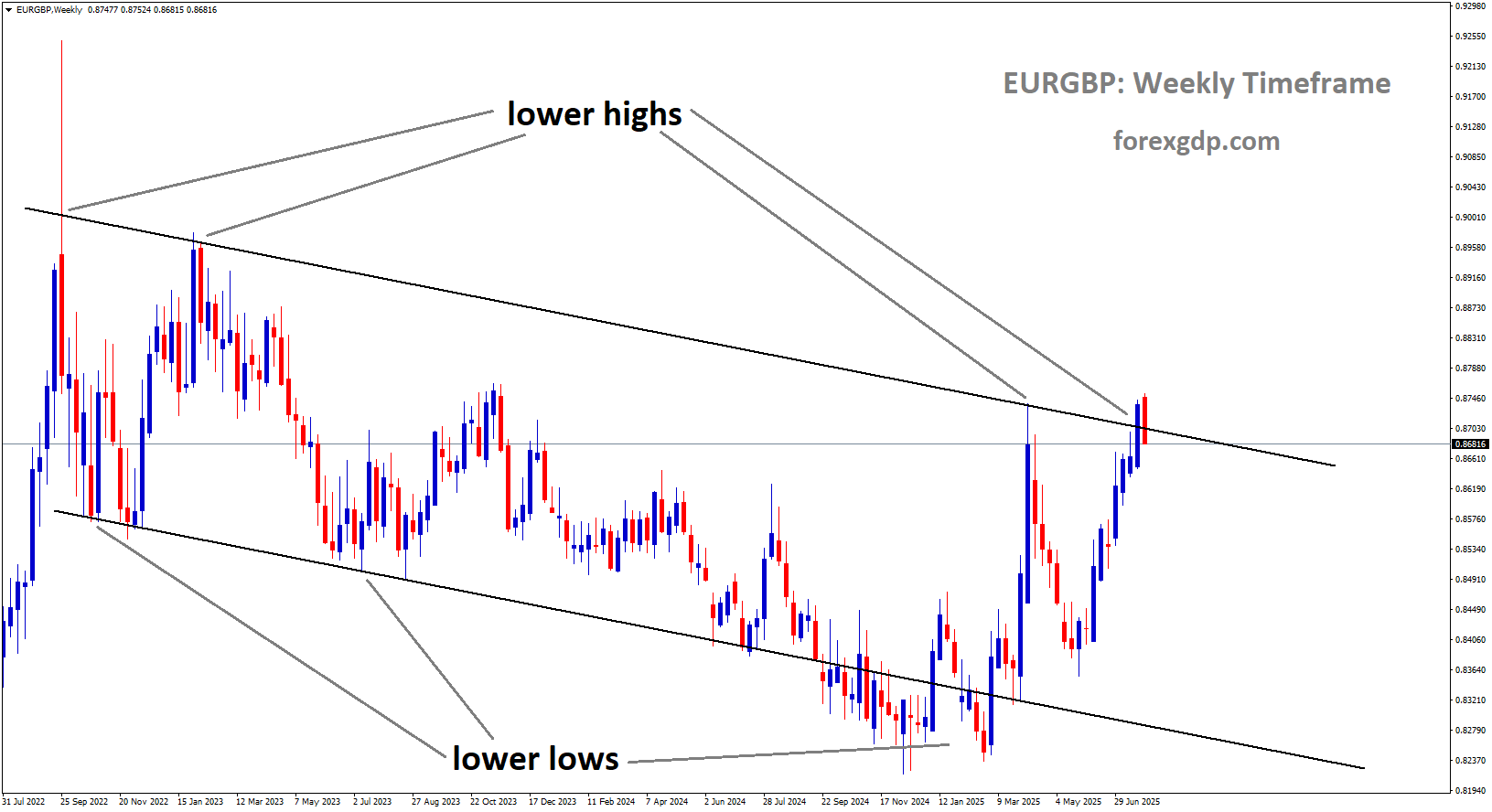
EURGBP is moving in a descending channel, and the market has reached the lower high area of the channel
Why This Matters for Traders and Investors
Understanding the bigger picture is crucial when it comes to forex. It’s not just about charts or numbers — it’s about the stories behind the currencies.
In this case, the story is that the Euro is gaining strength thanks to better-than-expected political and trade stability, while the Pound is facing pressure due to weak consumer spending and broader economic worries.
This shift in momentum can create trading opportunities — or at the very least, helps traders make more informed decisions. Keeping an eye on key developments like trade deals, economic reports, and consumer behavior is just as important (if not more) than watching price charts all day.
Wrapping It Up: What’s Next for EUR/GBP?
The current rally in EUR/GBP isn’t just random — it’s rooted in real-world events and economic trends. A favorable trade deal between the US and the EU has strengthened confidence in the Euro, while softer UK economic data has weakened the Pound’s footing.
As always, there’s more data to come — especially those GDP figures from Germany and the Eurozone. These will be key in determining whether the Euro can keep up its upward pace or if we’re in for another twist in the story.
For now, though, the balance is tipping toward the Euro. Whether you’re trading, investing, or just keeping up with the news, it’s definitely worth paying attention to how these macroeconomic forces play out in the EUR/GBP pair.
Don’t trade all the time, trade forex only at the confirmed trade setups
Get more confirmed trade signals at premium or supreme – Click here to get more signals, 2200%, 800% growth in Real Live USD trading account of our users – click here to see , or If you want to get FREE Trial signals, You can Join FREE Signals Now!

